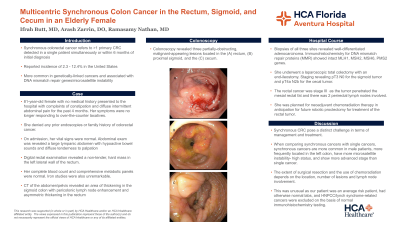Back


Poster Session A - Sunday Afternoon
Category: Colon
A0113 - Multicentric, Synchronous Colon Cancer in the Rectum, Sigmoid and Cecum in an Elderly Female
Sunday, October 23, 2022
5:00 PM – 7:00 PM ET
Location: Crown Ballroom

Has Audio

Ifrah Butt, MD
HCA Florida Aventura Hospital
Aventura, FL
Presenting Author(s)
Ifrah Butt, MD1, Niel Dave, MD1, Ramasamy S. Nathan, MD2
1HCA Florida Aventura Hospital, Aventura, FL; 2HCA Florida Aventura Hospital, Plantation, FL
Introduction: Multicentric tumors are more common in genetically-linked cancers. In most instances, tumor occurrence in a different location is due to recurrence of the malignancy. Our case illustrates a rare endoscopic finding of three distinct and synchronous adenocarcinomas of the rectum, sigmoid colon, and cecum in an otherwise healthy elderly female at an average risk for colorectal cancer.
Case Description/Methods: An 81-year-old female with no medical history presented to the hospital with constipation and diffuse intermittent abdominal pain for 4 months. She had been self-medicating at home with over-the-counter laxatives but recently reported that she was not experiencing relief. She denied any prior endoscopy or family history of colorectal cancer. On admission, her vital signs were normal and her physical exam was significant for diffuse abdominal tenderness to palpation. Digital rectal examination revealed a non-tender, hard mass in the left lateral wall of the rectum. Her complete blood count and comprehensive metabolic panels were normal. Iron studies were also unremarkable. A computed tomography (CT) scan of the abdomen and pelvis showed thickening in the sigmoid colon and the rectum with scattered subcentimeter lymph nodes. On colonoscopy, she was found to have three partially-obstructing, malignant-appearing lesions located in the rectum, proximal sigmoid, and cecum. Biopsies of all three sites revealed adenocarcinoma. Immunohistochemistry for DNA mismatch repair proteins (MMR) showed intact MLH1, MSH2, MSH6, PMS2 genes. She underwent a laparoscopic total colectomy with end ileostomy, with pathological staging revealing pT3 N0 for the sigmoid tumor and pT4a N2b for the cecal tumor. She was planned for neoadjuvant chemoradiation therapy in anticipation for future robotic proctectomy for treatment of the rectal tumor.
Discussion: Synchronous colorectal cancers pose a distinct challenge in terms of management and treatment. The extent of surgical resection and the use of chemoradiation depends on the location, number of lesions, and lymph node involvement. Our patient was an interesting case as she presented later in life and her only symptom was constipation. She was an average risk patient, had otherwise normal labs, and HNPCC/lynch syndrome-related cancers were excluded on the basis of normal immunohistochemistry testing.

Disclosures:
Ifrah Butt, MD1, Niel Dave, MD1, Ramasamy S. Nathan, MD2. A0113 - Multicentric, Synchronous Colon Cancer in the Rectum, Sigmoid and Cecum in an Elderly Female, ACG 2022 Annual Scientific Meeting Abstracts. Charlotte, NC: American College of Gastroenterology.
1HCA Florida Aventura Hospital, Aventura, FL; 2HCA Florida Aventura Hospital, Plantation, FL
Introduction: Multicentric tumors are more common in genetically-linked cancers. In most instances, tumor occurrence in a different location is due to recurrence of the malignancy. Our case illustrates a rare endoscopic finding of three distinct and synchronous adenocarcinomas of the rectum, sigmoid colon, and cecum in an otherwise healthy elderly female at an average risk for colorectal cancer.
Case Description/Methods: An 81-year-old female with no medical history presented to the hospital with constipation and diffuse intermittent abdominal pain for 4 months. She had been self-medicating at home with over-the-counter laxatives but recently reported that she was not experiencing relief. She denied any prior endoscopy or family history of colorectal cancer. On admission, her vital signs were normal and her physical exam was significant for diffuse abdominal tenderness to palpation. Digital rectal examination revealed a non-tender, hard mass in the left lateral wall of the rectum. Her complete blood count and comprehensive metabolic panels were normal. Iron studies were also unremarkable. A computed tomography (CT) scan of the abdomen and pelvis showed thickening in the sigmoid colon and the rectum with scattered subcentimeter lymph nodes. On colonoscopy, she was found to have three partially-obstructing, malignant-appearing lesions located in the rectum, proximal sigmoid, and cecum. Biopsies of all three sites revealed adenocarcinoma. Immunohistochemistry for DNA mismatch repair proteins (MMR) showed intact MLH1, MSH2, MSH6, PMS2 genes. She underwent a laparoscopic total colectomy with end ileostomy, with pathological staging revealing pT3 N0 for the sigmoid tumor and pT4a N2b for the cecal tumor. She was planned for neoadjuvant chemoradiation therapy in anticipation for future robotic proctectomy for treatment of the rectal tumor.
Discussion: Synchronous colorectal cancers pose a distinct challenge in terms of management and treatment. The extent of surgical resection and the use of chemoradiation depends on the location, number of lesions, and lymph node involvement. Our patient was an interesting case as she presented later in life and her only symptom was constipation. She was an average risk patient, had otherwise normal labs, and HNPCC/lynch syndrome-related cancers were excluded on the basis of normal immunohistochemistry testing.

Figure: Partially-obstructing malignant lesions in the (A) rectum, (B) proximal sigmoid, and (C) cecum.
Disclosures:
Ifrah Butt indicated no relevant financial relationships.
Niel Dave indicated no relevant financial relationships.
Ramasamy Nathan indicated no relevant financial relationships.
Ifrah Butt, MD1, Niel Dave, MD1, Ramasamy S. Nathan, MD2. A0113 - Multicentric, Synchronous Colon Cancer in the Rectum, Sigmoid and Cecum in an Elderly Female, ACG 2022 Annual Scientific Meeting Abstracts. Charlotte, NC: American College of Gastroenterology.
